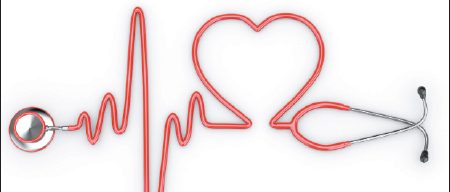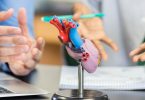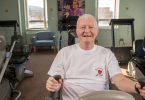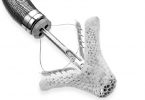In the movies, when someone has a heart attack, there’s an enormous amount of chest clutching and frantic action to call 911. But, in fact, says James J. Vincens, MD, FACC, a cardiologist with Cardiology Associates who practices at UHS Wilson Medical Center, this high drama is not always the case. “Heart attack symptoms can be confusing, because they often come on slowly or they’re misread as indigestion or shortness of breath,” he says. “And there may be no chest pain at all — especially in the elderly, who are more likely to have atypical symptoms such as shortness of breath or fatigue.”
It’s this confusion that prompts many heart attack victims to delay getting medical attention, which can result in serious heart damage or death. Clot-busting drugs and other artery-opening treatments work best when given as soon as possible after a heart attack starts. The first hour or so after heart attack symptoms begin also is when your heart is most likely to stop suddenly. Getting help fast increases your chance of surviving.
Know the Symptoms
 A study conducted by the Centers for Disease Control and Prevention found that 92 percent of those surveyed recognized chest pain as a primary heart attack symptom but only 27 percent knew all major symptoms and when to call 911. This represents a deadly knowledge gap.
A study conducted by the Centers for Disease Control and Prevention found that 92 percent of those surveyed recognized chest pain as a primary heart attack symptom but only 27 percent knew all major symptoms and when to call 911. This represents a deadly knowledge gap.
To close this gap and protect your life, learn all the warning signs for men and women, beginning with the fact that classic chest pain is not always present, and anyone — a man or a woman — may suffer atypical heart attack symptoms.
It’s also important to understand that women’s symptoms tend to be less predictable and more atypical. Therefore, if you suffer one or more of the following symptoms, even if you’re not sure it’s a heart attack, call 911 within five minutes of when symptoms begin.
- chest pain, pressure or discomfort that may remain steady or come and go
- discomfort in the upper body, which may include pain in one or both arms, shoulders, neck, back or jaw
- shortness of breath
- dizziness or lightheadedness
- fatigue or weakness
- excessive cold sweats
- unexplained nausea and vomiting
- pain in the upper abdomen
- indigestion
Don’t Kill Time
 During a heart attack, nourishing, oxygen-rich blood flow to the heart is reduced or cut off, most often due to a blocked blood vessel. When deprived of blood, heart muscle cells begin to die. The sooner you get to the hospital emergency room so blood flow can be restored, the better your chances of survival. To expedite matters, you need to call 911 and never drive yourself or a loved one to the hospital, stresses Dr. Vincens. “Paramedics can administer lifesaving medication en route to the hospital and also monitor and treat arrhythmias — abnormal heart rhythms that can cause sudden death — until the patient reaches the ER.”
During a heart attack, nourishing, oxygen-rich blood flow to the heart is reduced or cut off, most often due to a blocked blood vessel. When deprived of blood, heart muscle cells begin to die. The sooner you get to the hospital emergency room so blood flow can be restored, the better your chances of survival. To expedite matters, you need to call 911 and never drive yourself or a loved one to the hospital, stresses Dr. Vincens. “Paramedics can administer lifesaving medication en route to the hospital and also monitor and treat arrhythmias — abnormal heart rhythms that can cause sudden death — until the patient reaches the ER.”
To ensure the best possible care for its patients, UHS Wilson Medical Center partners with ambulance agencies equipped with the LifeNet system, a high-tech data exchange program that lets life support providers respond to a 911 call, assess the patient’s heart with a detailed 12-lead electrocardiogram (ECG), and transmit ECG results to the UHS Wilson emergency department over a secure Internet connection. The ER team reviews the data while the patient is on the to the hospital and, if necessary, contacts the cardiologist and prepares the cardiac catheterization lab. With this system, a patient arrives in the ER with the team already up to speed, the cath lab open and the cardiologist ready.
Beat the Clock
Once the patient reaches the hospital, a new clock begins ticking. It’s called door-to-balloon time, which means the time it takes to get a heart attack patient from the hospital door into a hospital catheterization lab for an angioplasty or other interventional procedure to restore blood flow. An acceptable door-to-balloon time, according to the American Heart Association, is 90 minutes, and each minute longer means potential permanent damage to the patient’s heart muscle.
Due to continuous process improvement efforts, thorough case review and the high-tech data exchange between life support providers in the ambulance and the ER team back at the hospital, UHS Wilson’s median door-to-balloon time is 72 minutes. “The sooner you open a blocked artery, the less damage there is to the heart muscle,” Dr. Vincens stresses. And that, the doctor adds, greatly increases your chance for a healthy recovery — with plenty more time to enjoy life!
UHS Wilson’s median door-to-balloon time is 72 minutes. 90 minutes is an acceptable door-to-balloon time, according to the American Heart Association.







